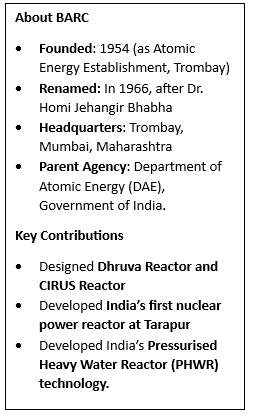Syllabus:
GS3: Achievements of Indians in science & technology; indigenization of technology and developing new technology.
Context:
Recently, India has inaugurated its first private test facility for the upgrading of depleted heavy water, commissioned by TEMA India Ltd.
More on the News

- This modern facility was built by TEMA, designed using technology transferred from BARC (Bhabha Atomic Research Centre) and developed under a purchase order from NPCIL (Nuclear Power Corporation of India Limited).
- It is the first of its kind to be developed in the private sector.
- The development is firmly aligned with the Prime Minister’s Atma-nirbhar Bharat initiative. It symbolizes the entry of India’s private sector into advanced nuclear component validation.
- Until now, critical testing infrastructure for heavy water distillation components has existed solely within BARC.
- India has dispatched the first approved batch of eight Distillation Column sections.
- They are made up with activated phosphor bronze modules and are essential parts of Pressurised Heavy Water Reactors (PHWRs).
- These modules are set to be used in major nuclear power projects: RAPP Unit 8, GHAVP Units 1–4, and KAIGA Units 5 & 6.
Significance
- By designing, manufacturing and validating nuclear components entirely in-house, India reduces reliance on imported equipment and external test infrastructure.
- It helps build domestic capability, confidence and long-term resilience, empowering Indian firms to contribute meaningfully to national energy security goals.
- It sets a new benchmark for collaboration between private firms and state-run nuclear bodies.
About Nuclear Power Reactors
- Nuclear reactors work by using the heat energy released from splitting atoms of certain elements to generate electricity.
Components of the Nuclear Power Reactors:
- Fuel: Uranium is the basic fuel. Usually, pellets of uranium oxide (UO2) are arranged in tubes to form fuel rods. The rods are arranged into fuel assemblies in the reactor core. In a new reactor with new fuel, a neutron source is needed to get the reaction going.
- Moderator: Material in the core that slows down the neutrons released from fission so that they cause more fission. It is usually water but may be heavy water or graphite.
- Control rods or blades: Control rods, made of neutron-absorbing materials like cadmium, hafnium or boron to regulate or stop nuclear reactions. In PWRs, they enter from the top; in BWRs, cruciform blades insert from below. Boron in the coolant also serves as a secondary control system.
- Coolant: A fluid circulating through the core so as to transfer the heat from it. In light water reactors, the water moderator also functions as the primary coolant. Except in BWRs, there is a secondary coolant circuit where the water becomes steam.
- Pressure vessel or pressure tubes: Usually a robust steel vessel containing the reactor core and moderator/coolant but it may be a series of tubes holding the fuel and conveying the coolant through the surrounding moderator.

